
Shahzia Sikander is a citizen of the world. Over the course of three decades, Sikander has developed a multi-media practice that embraces the production of compelling objects that practically and theoretically transcend borders. Her meaningful artistic and social collaborations probe contested histories of colonialism, mechanisms of power, notions of language and migration. Sikander is internationally renowned for a pioneering practice that takes classical Indo-Persian miniature painting as its point of departure, and inflects it with contemporary South Asian, American, Feminist and Muslim perspectives. Sikander’s work stands in opposition to the idea of homogenous and authentic national cultures; instead, Sikander asks that we understand terms such as “tradition,” “culture” and “identity” as unstable, abstract and constantly evolving. Her interdisciplinary practice offers a different and more inclusive way that delimits the arbitrariness of geopolitical borders and radically disrupts assumptions around national, political, and art historical boundaries.
Born in Lahore, Pakistan, Shahzia Sikander took up the traditional practice of miniature painting during Muhammad Zia-ul-Haq’s military regime, at a time when the medium was deeply unpopular among young artists. Sikander earned a B.F.A. in 1991 from the National College of Arts (NCA) in Lahore, where she received rigorous training from master miniaturist Bashir Ahmad, becoming his first student and artist from the miniature painting department to challenge the medium’s technical and aesthetic framework. Sikander’s breakthrough work, The Scroll, 1989–90, received national critical acclaim in Pakistan, winning the prestigious Shakir Ali Award, the NCA’s highest merit award, and the Haji Sharif award for excellence in miniature painting. Sikander started teaching miniature painting at NCA in 1992, alongside Bashir Ahmad. Her work launched what is now globally called neo-miniature into the forefront of NCA’s program in the early 90s, encouraging students on the sidelines weary about prejudices around craft-based work to engage miniature painting with experimentation. In the late 90s to early 2000s Sikander's work in the international arena brought recognition to this medium within contemporary art practices across the world.
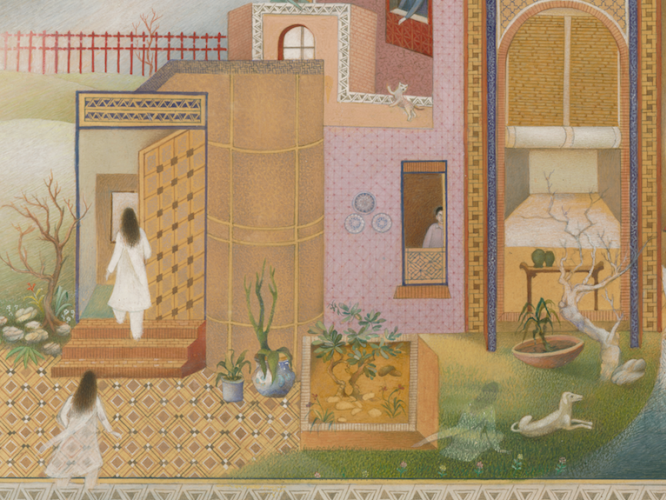
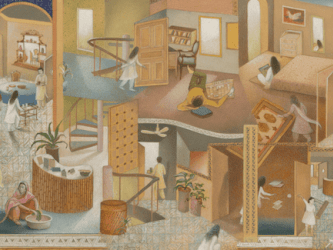

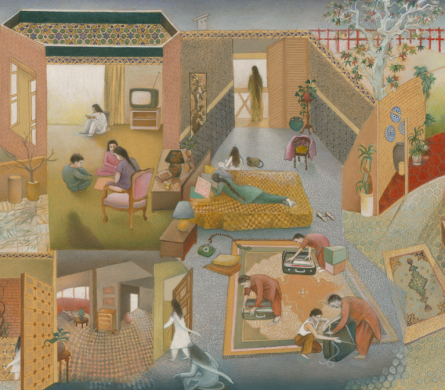
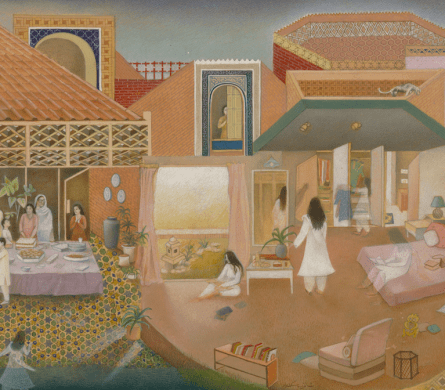
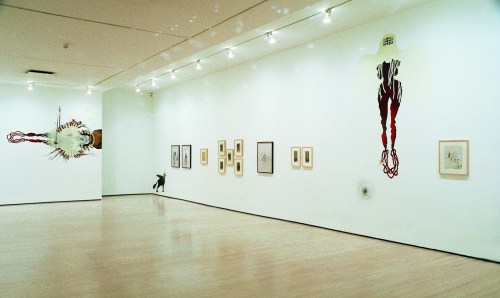
Is it me or is it you, 1997
Installation view at the Drawing Center
The artist moved to the United States to pursue an M.F.A. at the Rhode Island School of Design from 1993 to 1995; from 1995 to 1997, she participated in the CORE Program of the Glassell School of Art at The Museum of Fine Arts, Houston. In the 1990s, Sikander continued to be a technical pioneer, engaging with miniature painting in novel ways to include large-scale floor and wall drawings, installations, multimedia works and collaborations with other artists. The innovative work led to her international meteoric rise, as she participated in prominent exhibitions at leading venues in New York, including The Drawing Center (1997); Queens Museum (1997); Whitney Museum of American Art (1997); and Deitch Projects (1998).
Her work was the subject of important survey exhibitions, in 1998 at the Renaissance Society at the University of Chicago, Illinois and the Kemper Museum of Contemporary Art, Kansas City, Missouri; and in 1999 at the Hirshhorn Museum and Sculpture Garden in Washington, D.C. Following a residency at Artpace in Houston in 2001, she began experimenting with video and animation, marking a critical turning point in her career.
Since that time, major solo exhibitions of Sikander’s work have been held at the Whitney Museum of American Art at Altria (formerly Philip Morris) (2000); The Aldrich Contemporary Art Museum, Ridgefield, Connecticut (2004); The Frances Young Tang Teaching Museum and Art Gallery at Skidmore College, Saratoga Springs (2004); The San Diego Museum of Art, San Diego (2004); Otis College of Art and Design, Los Angeles (2005); Miami Art Museum, Miami (2005–06); Irish Museum of Modern Art, Dublin (2007); Museum of Contemporary Art, Sydney (2007); daadgalerie, Berlin (2008); IKON, Birmingham, U.K. (2008); Linda Pace Foundation, San Antonio (2012–13); Nikolaj Kunsthal, Copenhagen (2014); Bildmuseet, University of Umeä, Umeä, Sweden (2014); Guggenheim Bilbao, Bilbao, Spain (2015); Asia Society Hong Kong Center, Hong Kong (2016); MAXXI | Museo nazionale delle arti del XXI secolo, Rome (2016- 2017), Honolulu Art Museum, Hawaii (2017) and Weatherspoon Art Museum, North Carolina (2019).
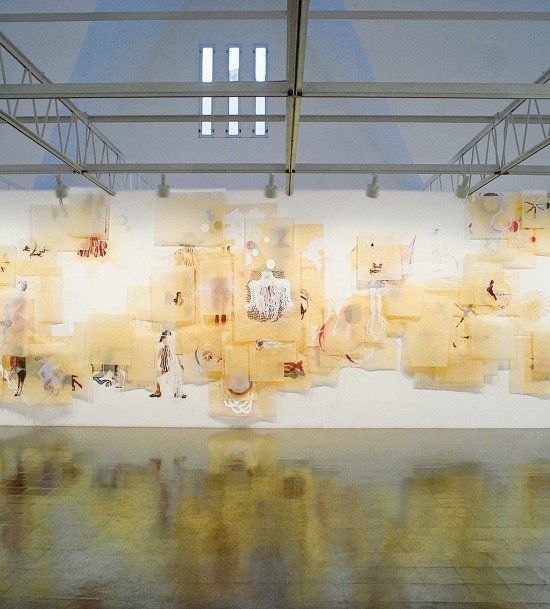
Among the numerous awards, grants, and fellowships Sikander has received are the Louis Comfort Tiffany Foundation Award (1997); Joan Mitchell Foundation grant (1998–99); South Asian Women’s Creative Collective Achievement Award (1999); Commendation Award, Mayor’s Office, New York (2003); Tamgha-e-Imtiaz, Medal of Excellence, Pakistani Government (2005); Jennifer Howard Coleman Distinguished Lectureship and Residency Program, OTIS College of Art and Design, Los Angeles (2005); MacArthur Fellowship, John D. and Catherine T. MacArthur Foundation (2006); Young Global Leader, World Economic Forum (2006–11); Berliner Künstlerprogramm, Deutscher Akademischer Austauschdienst (DAAD), Berlin (2007–08); Performing and Visual Arts Achiever of the Year Award, South Asian Excellence Awards, New York (2008); National Medal of Arts Award, U.S. Department of State (2012); ArtPrize in Time-Based Art, Grand Rapids Art Museum (2013); Asia Society Award for Significant Contribution to Contemporary Art (2015); and the American Academy of Religion, Religion and the Arts Award (2016); and the Shahneela and Farhan Faruqui Popular Choice Art Prize at the Karachi Biennale (2017).
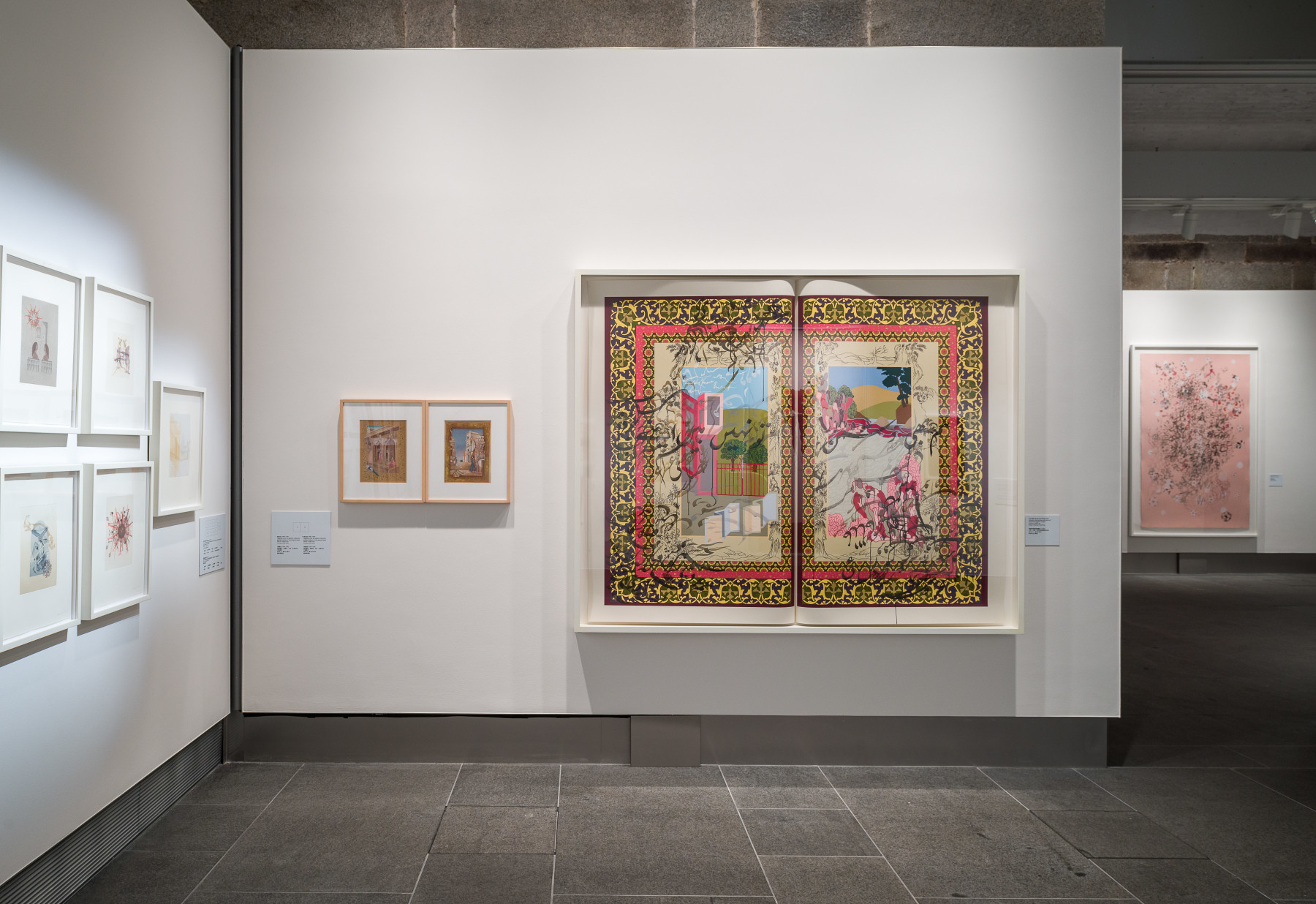
Apparatus of Power, March 16 -July 9, 2016
Asia Society Hong Kong
Sikander’s work is included in the permanent collection of prestigious institutions worldwide, including the Art Gallery of New South Wales, Sydney, Australia; Asian Art Museum, San Francisco, California; Blanton Museum of Art, The University of Texas at Austin, Austin, Texas; Bristol City Museum & Art Gallery, Bristol, U.K.; Brooklyn Museum, New York; Burger Collection, Hong Kong, China; Cartwright Hall Art Gallery, Bradford Museums and Galleries, Bradford, U.K.; DESTE Foundation for Contemporary Art, Athens, Greece; Fukuoka Art Museum, Fukuoka, Japan; Hammer Museum, Los Angeles; Hirshhorn Museum and Sculpture Garden, Washington, D.C.; Kiran Nadar Museum of Art, New Delhi; Linda Pace Foundation, San Antonio, Texas; MAXXI | Museo nazionale delle arti del XXI secolo, Rome; The Metropolitan Museum of Art, New York; Museum of Contemporary Art, Los Angeles; Museum of Contemporary Art Tokyo, Tokyo; Museum of Fine Arts, Boston; Museum of Fine Arts, Houston; The Museum of Modern Art, New York; National Portrait Gallery, Washington, D.C.; Newark Museum, Newark, New Jersey; Philadelphia Museum of Art, Philadelphia; Princeton University Art Museum, Princeton, N.J.; Rhode Island School of Design Museum, Providence; Royal Ontario Museum, Toronto; The San Diego Museum of Art, San Diego; San Francisco Museum of Modern Art, San Francisco; Solomon R. Guggenheim Museum, New York; and Whitney Museum of American Art, New York.
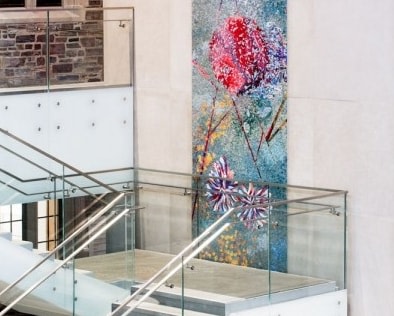
Ecstasy as Sublime, Heart as Vector, 2016
Glass, Ceramic, Marble
In 2016, Sikander completed a site-specific animation, Disruption as Rapture, commissioned by the Philadelphia Museum of Art on the occasion of the reopening of their South Asian galleries, and her first major public art commission, a 66-foot mosaic and 25-foot glass painting at Princeton University, unveiled April 2017. In 2019, Sikander created a 28-foot fountain in mosaic which is now installed permanently in Mid-Town Park, Houston, Texas. She is the first Pakistani-American to be inducted in the National Portrait Gallery Smithsonian (2017) and the first Pakistani to win the inaugural US State Department’s National Medal of Art (2012). Sikander has been appointed to the Mayoral Advisory Commission on City Art, Monuments, and Markers in New York City, where she currently lives. She also serves on the boards of Art 21 and the Rhode Island School of Design.